A Four-Port MIMO Cylindrical DRA with High Isolation in Ultra-Compact Size for WLAN Applications
Abstract
:1. Introduction
2. Antenna Geometry and Design
2.1. Antenna Configuration
2.2. Decoupling Mechanism and Antenna Design
3. Results and Discussion
4. Conclusions
Author Contributions
Funding
Data Availability Statement
Conflicts of Interest
References
- Jensen, M.A.; Wallace, J.W. A Review of Antennas and Propagation for MIMO Wireless Communications. IEEE Trans. Antennas Propag. 2004, 52, 2810–2824. [Google Scholar] [CrossRef]
- Zhou, Q.; Dai, H. Joint Antenna Selection and Link Adaptation for MIMO Systems. IEEE Trans. Veh. Technol. 2006, 55, 243–255. [Google Scholar] [CrossRef]
- Tian, R.; Lau, B.K.; Ying, Z. Multiplexing Efficiency of MIMO Antennas. IEEE Antennas Wirel. Propag. Lett. 2011, 10, 183–186. [Google Scholar] [CrossRef]
- Yan, J.; Bernhard, J.T. Implementation of a Frequency-Agile MIMO Dielectric Resonator Antenna. IEEE Trans. Antennas Propag. 2013, 61, 3434–3441. [Google Scholar] [CrossRef]
- Li, W.; Leung, K.W.; Yang, N. Omnidirectional Dielectric Resonator Antenna with a Planar Feed for Circular Polarization Diversity Design. IEEE Trans. Antennas Propag. 2018, 66, 1189–1197. [Google Scholar] [CrossRef]
- Wu, Q. Characteristic Mode Assisted Design of Dielectric Resonator Antennas with Feedings. IEEE Trans. Antennas Propag. 2019, 67, 5294–5304. [Google Scholar] [CrossRef]
- Yang, N.; Leung, K.W.; Wu, N. Pattern-Diversity Cylindrical Dielectric Resonator Antenna Using Fundamental Modes of Different Mode Families. IEEE Trans. Antennas Propag. 2019, 67, 6778–6788. [Google Scholar] [CrossRef]
- Kowalewski, J.; Eisenbeis, J.; Jauch, A.; Mayer, J.; Kretschmann, M.; Zwick, T. A mmW Broadband Dual-Polarized Dielectric Resonator Antenna Based on Hybrid Modes. IEEE Antennas Wirel. Propag. Lett. 2020, 19, 1068–1072. [Google Scholar] [CrossRef]
- Sun, Y.X.; Leung, K.W. Dual-Band and Wideband Dual-Polarized Cylindrical Dielectric Resonator Antennas. IEEE Antennas Wirel. Propag. Lett. 2013, 12, 384–387. [Google Scholar] [CrossRef]
- Nasir, J.; Jamaluddin, M.H.; Ahmad Khan, A.; Kamarudin, M.R.; Leow, C.Y.; Owais, O. Throughput Measurement of a Dual-Band MIMO Rectangular Dielectric Resonator Antenna for LTE Applications. Sensors 2017, 17, 148. [Google Scholar] [CrossRef]
- Fang, X.S.; Leung, K.W.; Luk, K.M. Theory and Experiment of Three-Port Polarization-Diversity Cylindrical Dielectric Resonator Antenna. IEEE Trans. Antennas Propag. 2014, 62, 4945–4951. [Google Scholar] [CrossRef]
- Tang, H.; Tong, C.; Chen, J. Differential Dual-Polarized Filtering Dielectric Resonator Antenna. IEEE Trans. Antennas Propag. 2018, 66, 4298–4302. [Google Scholar] [CrossRef]
- Abdalrazik, A.; El-Hameed, A.S.A.; Abdel-Rahman, A.B. A Three-Port MIMO Dielectric Resonator Antenna Using Decoupled Modes. IEEE Antennas Wirel. Propag. Lett. 2017, 16, 3104–3107. [Google Scholar] [CrossRef]
- Sharawi, M.S.; Khan, M.U.; Numan, A.B.; Aloi, D.N. A CSRR Loaded MIMO Antenna System for ISM Band Operation. IEEE Trans. Antennas Propag. 2013, 61, 4265–4274. [Google Scholar] [CrossRef]
- Zhang, Y.; Deng, J.Y.; Li, M.J.; Sun, D.; Guo, L.X. A MIMO Dielectric Resonator Antenna with Improved Isolation for 5G mm-Wave Applications. IEEE Antennas Wirel. Propag. Lett. 2019, 18, 747–751. [Google Scholar] [CrossRef]
- Abdel-Wahab, W.M.; Abdallah, M.; Anderson, J.; Wang, Y.; Al-Saedi, H.; Safavi-Naeini, S. SIW-Integrated Parasitic DRA Array: Analysis, Design, and Measurement. IEEE Antennas Wirel. Propag. Lett. 2019, 18, 69–73. [Google Scholar] [CrossRef]
- Ibrahim, A.A.; Zahra, H.; Abbas, S.M.; Ahmed, M.I.; Varshney, G.; Mukhopadhyay, S.; Mahmoud, A. Compact Four-Port Circularly Polarized MIMO X-Band DRA. Sensors 2022, 22, 4461. [Google Scholar] [CrossRef]
- Song, S.; Chen, X.; Da, Y.; Kishk, A.A. Broadband Dielectric Resonator Antenna Array with Enhancement of Isolation and Front-to-Back Ratio for MIMO Application. IEEE Antennas Wirel. Propag. Lett. 2022, 21, 1487–1491. [Google Scholar] [CrossRef]
- Li, J.; Zeng, Q.; Liu, R.; Denidni, T.A. Beam-Tilting Antenna with Negative Refractive Index Metamaterial Loading. IEEE Antennas Wirel. Propag. Lett. 2017, 16, 2030–2033. [Google Scholar] [CrossRef]
- Farahani, M.; Pourahmadazar, J.; Akbari, M.; Nedil, M.; Sebak, A.R.; Denidni, T.A. Mutual Coupling Reduction in Millimeter-Wave MIMO Antenna Array Using a Metamaterial Polarization-Rotator Wall. IEEE Antennas Wirel. Propag. Lett. 2017, 16, 2324–2327. [Google Scholar] [CrossRef]
- Das, G.; Sharma, A.; Gangwar, R.K.; Sharawi, M.S. Performance Improvement of Multiband MIMO Dielectric Resonator Antenna System with a Partially Reflecting Surface. IEEE Antennas Wirel. Propag. Lett. 2019, 18, 2105–2109. [Google Scholar] [CrossRef]
- Das, G.; Sahu, N.K.; Sharma, A.; Gangwar, R.K.; Sharawi, M.S. FSS-Based Spatially Decoupled Back-to-Back Four-Port MIMO DRA With Multidirectional Pattern Diversity. IEEE Antennas Wirel. Propag. Lett. 2019, 18, 1552–1556. [Google Scholar] [CrossRef]
- Kumari, T.; Das, G.; Gangwar, R.K. Spatially Decoupled 8-port Box Shaped MIMO DRA with Quad-directional Pattern Diversity. J. Electromagn. Waves Appl. 2021, 35, 1221–1234. [Google Scholar] [CrossRef]
- Das, G.; Sharma, A.; Gangwar, R.K.; Sharawi, M.S. Compact back-to-back DRA-based four-port MIMO antenna system with bi-directional diversity. Electron. Lett. 2018, 54, 884–886. [Google Scholar] [CrossRef]
- Pan, Y.M.; Hu, Y.; Zheng, S.Y. Design of Low Mutual Coupling Dielectric Resonator Antennas Without Using Extra Decoupling Element. IEEE Trans. Antennas Propag. 2021, 69, 7377–7385. [Google Scholar] [CrossRef]
- Sahu, N.K.; Das, G.; Gangwar, R.K.; Rambabu, K. An Arrangement for Four-Element MIMO DRA with Complementary CP Diversity. IEEE Antennas Wirel. Propag. Lett. 2021, 20, 1616–1620. [Google Scholar] [CrossRef]
- Hu, Y.; Pan, Y.M.; Di Yang, M. Circularly Polarized MIMO Dielectric Resonator Antenna with Reduced Mutual Coupling. IEEE Trans. Antennas Propag. 2021, 69, 3811–3820. [Google Scholar] [CrossRef]
- Sun, L.; Li, Y.; Zhang, Z.; Wang, H. Antenna Decoupling by Common and Differential Modes Cancellation. IEEE Trans. Antennas Propag. 2021, 69, 672–682. [Google Scholar] [CrossRef]
- Sun, L.; Li, Y.; Zhang, Z. Decoupling Between Extremely Closely Spaced Patch Antennas by Mode Cancellation Method. IEEE Trans. Antennas Propag. 2021, 69, 3074–3083. [Google Scholar] [CrossRef]
- Chang, L.; Wang, H. Miniaturized Wideband Four-Antenna Module Based on Dual-Mode PIFA for 5G 4 × 4 MIMO Applications. IEEE Trans. Antennas Propag. 2021, 69, 5297–5304. [Google Scholar] [CrossRef]
- Barani, I.R.R.; Wong, K.-L.; Zhang, Y.-X.; Li, W.-Y. Low-Profile Wideband Conjoined Open-Slot Antennas Fed by Grounded Coplanar Waveguides for 4 × 4 5G MIMO Operation. IEEE Trans. Antennas Propag. 2020, 68, 2646–2657. [Google Scholar] [CrossRef]
- Chang, L.; Zhang, G.; Wang, H. Dual-Band Antenna Pair with Lumped Filters for 5G MIMO Terminals. IEEE Trans. Antennas Propag. 2021, 69, 5413–5423. [Google Scholar] [CrossRef]
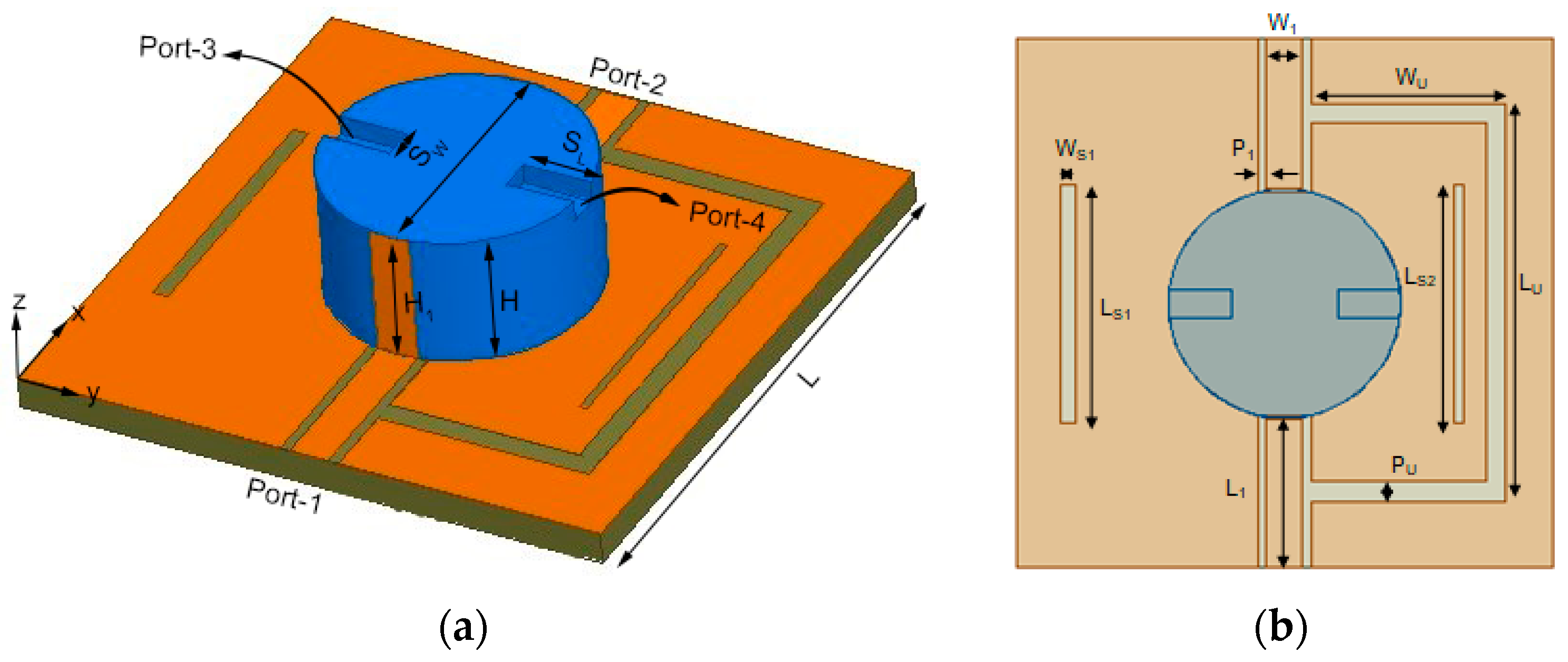
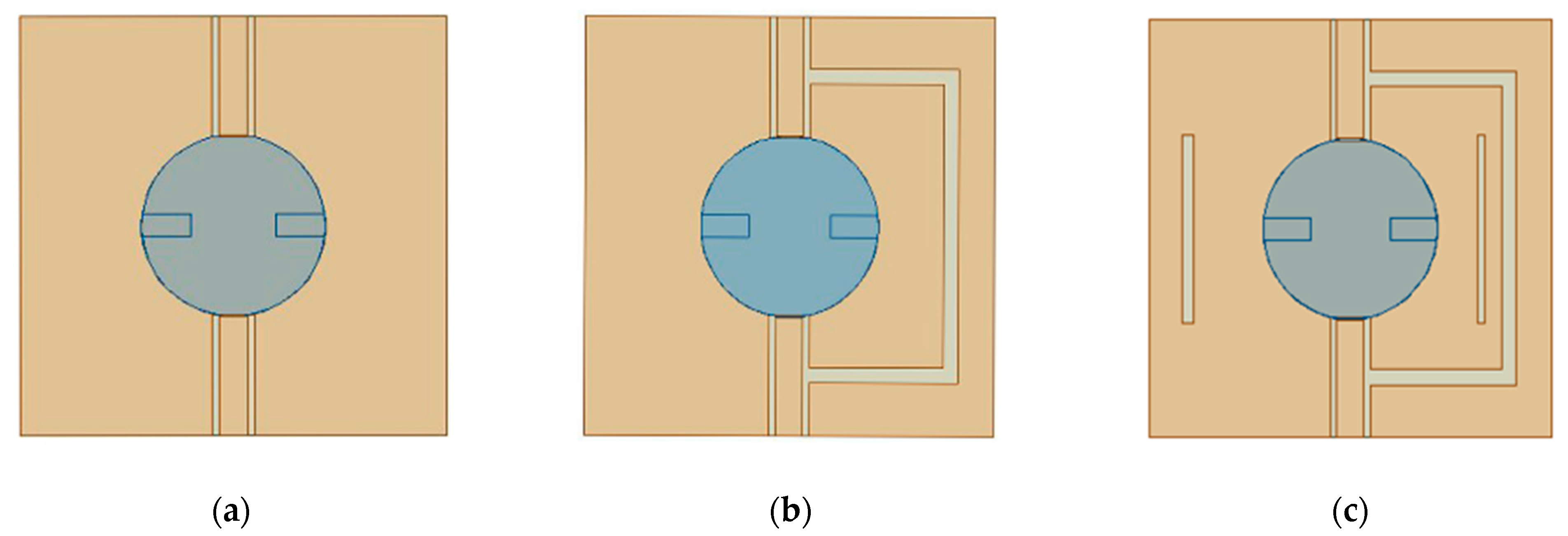

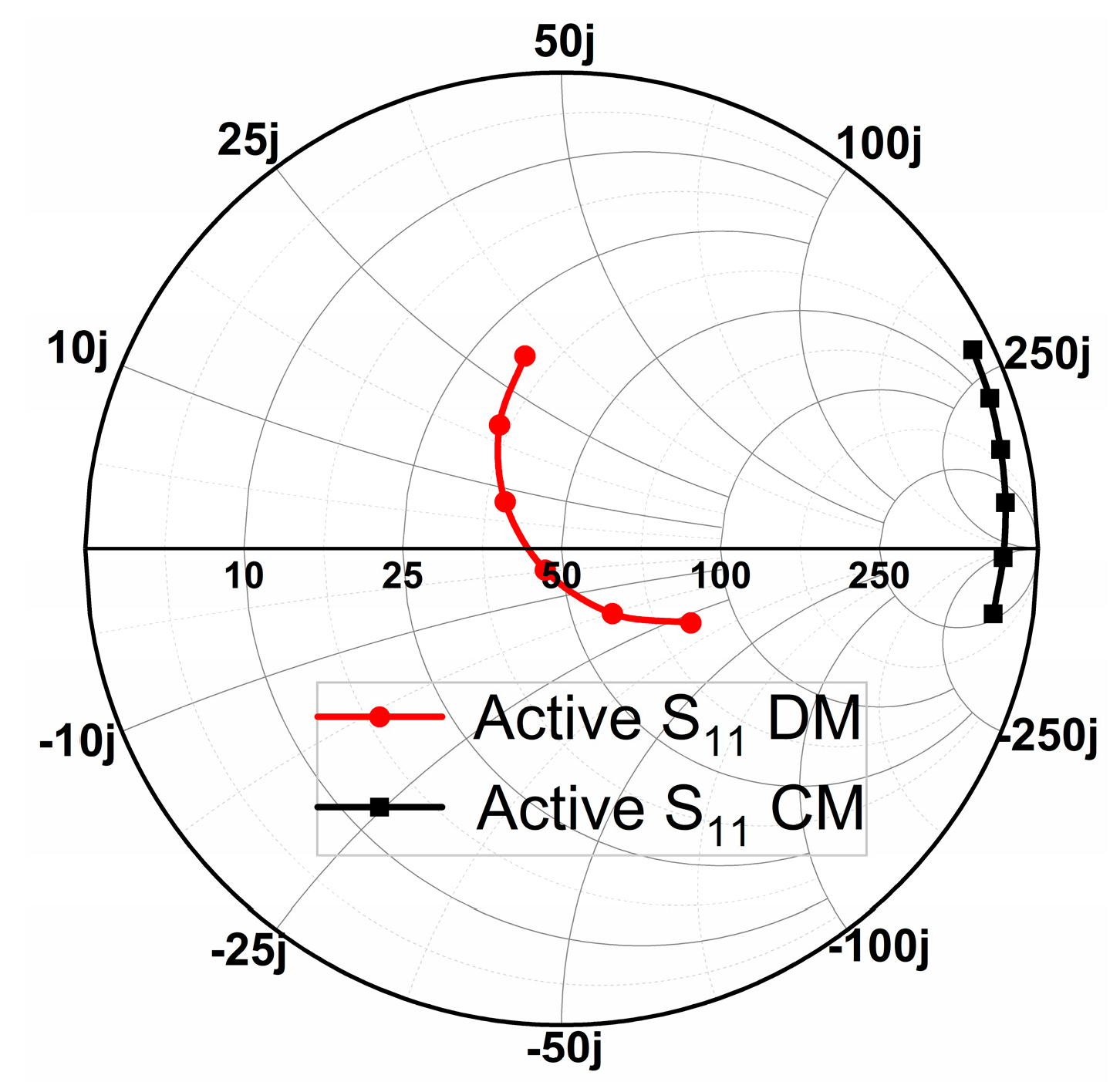



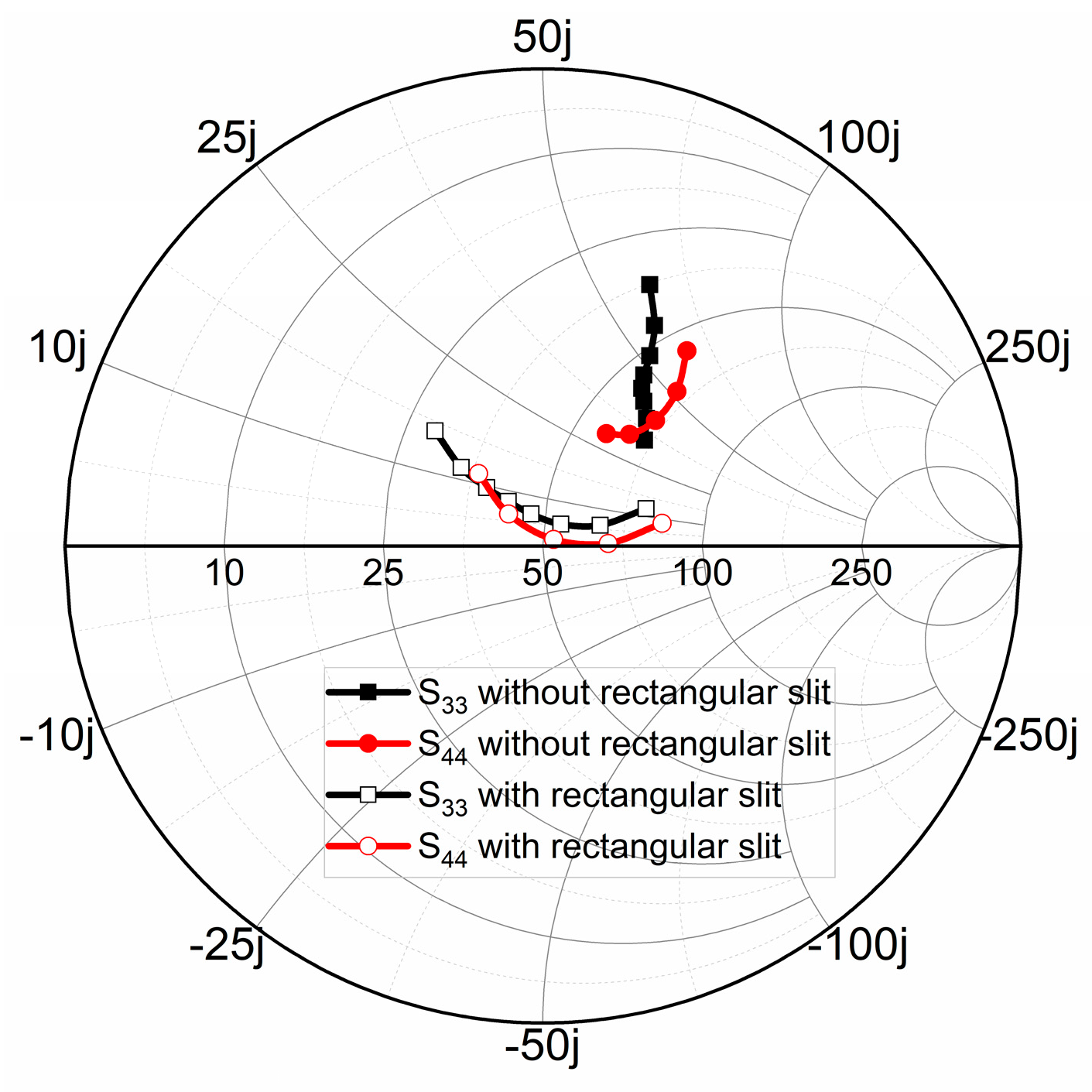
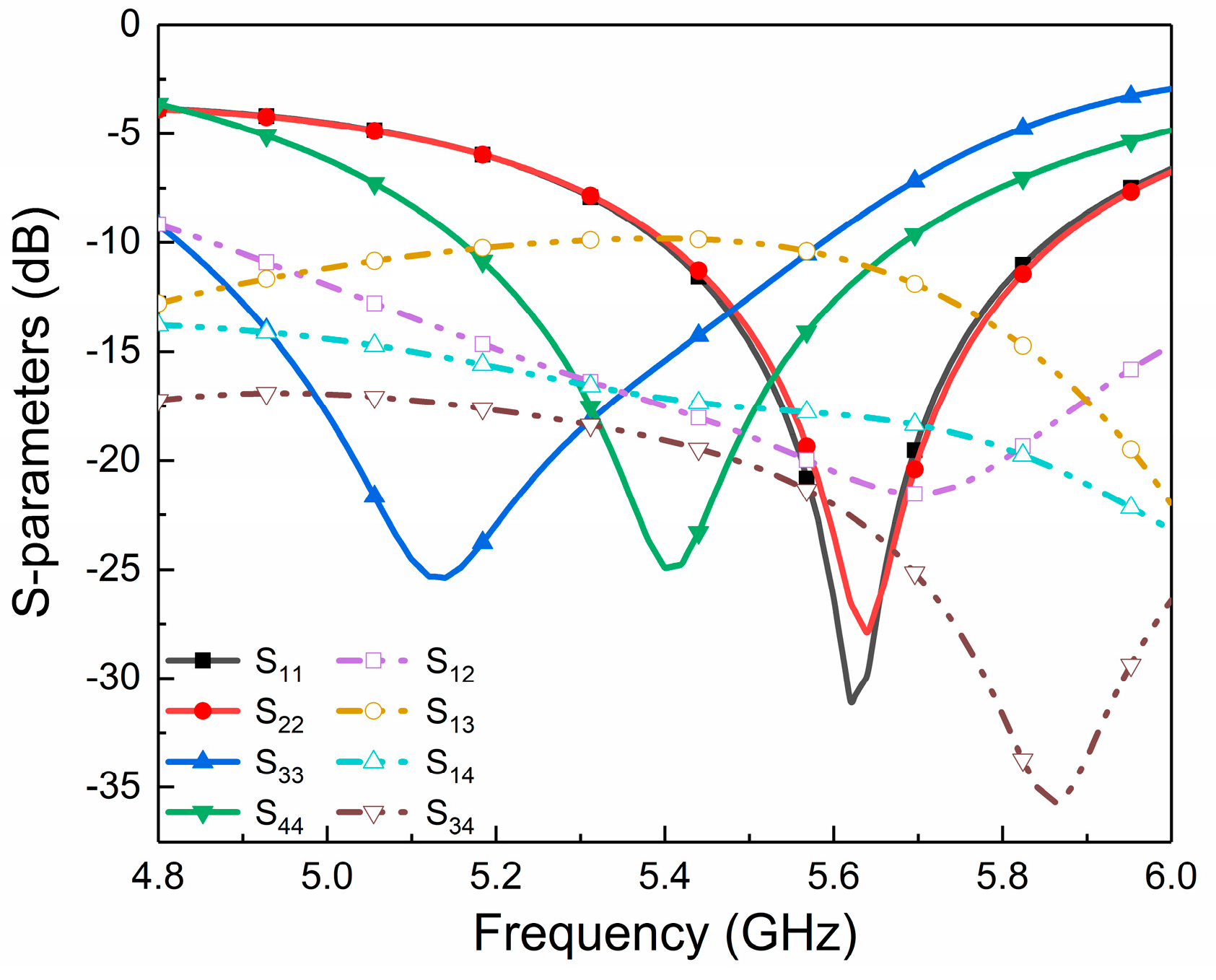

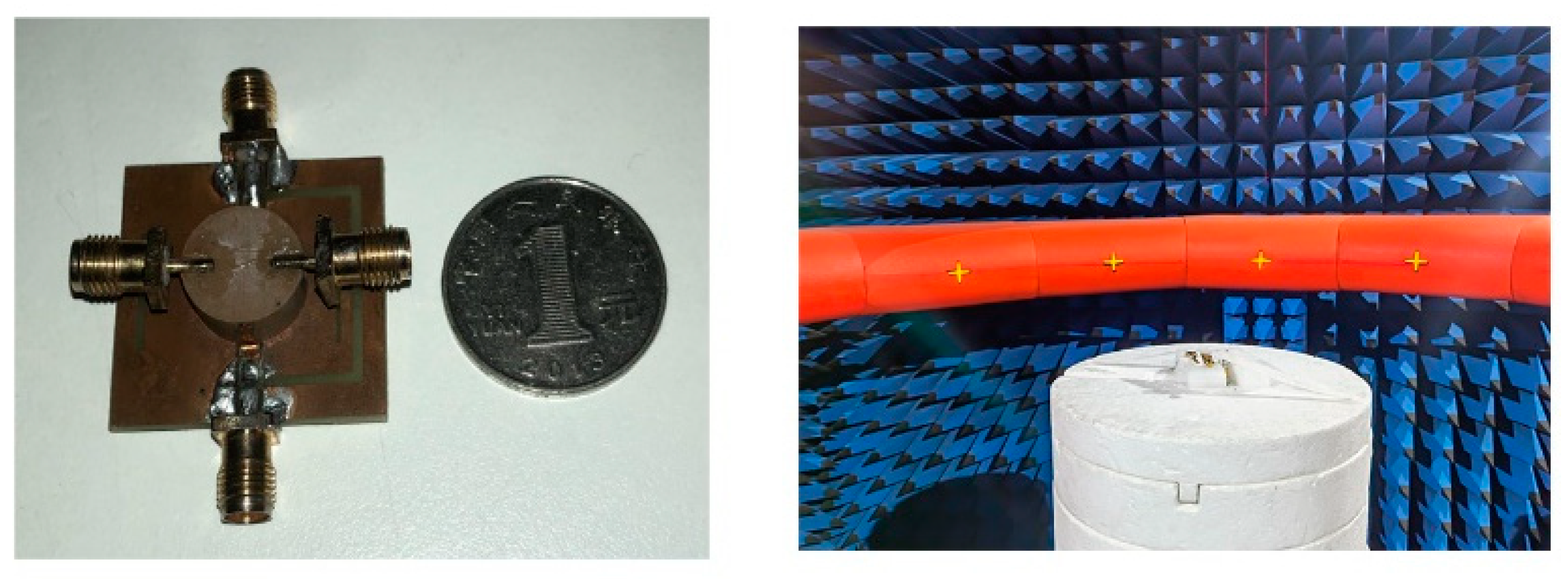
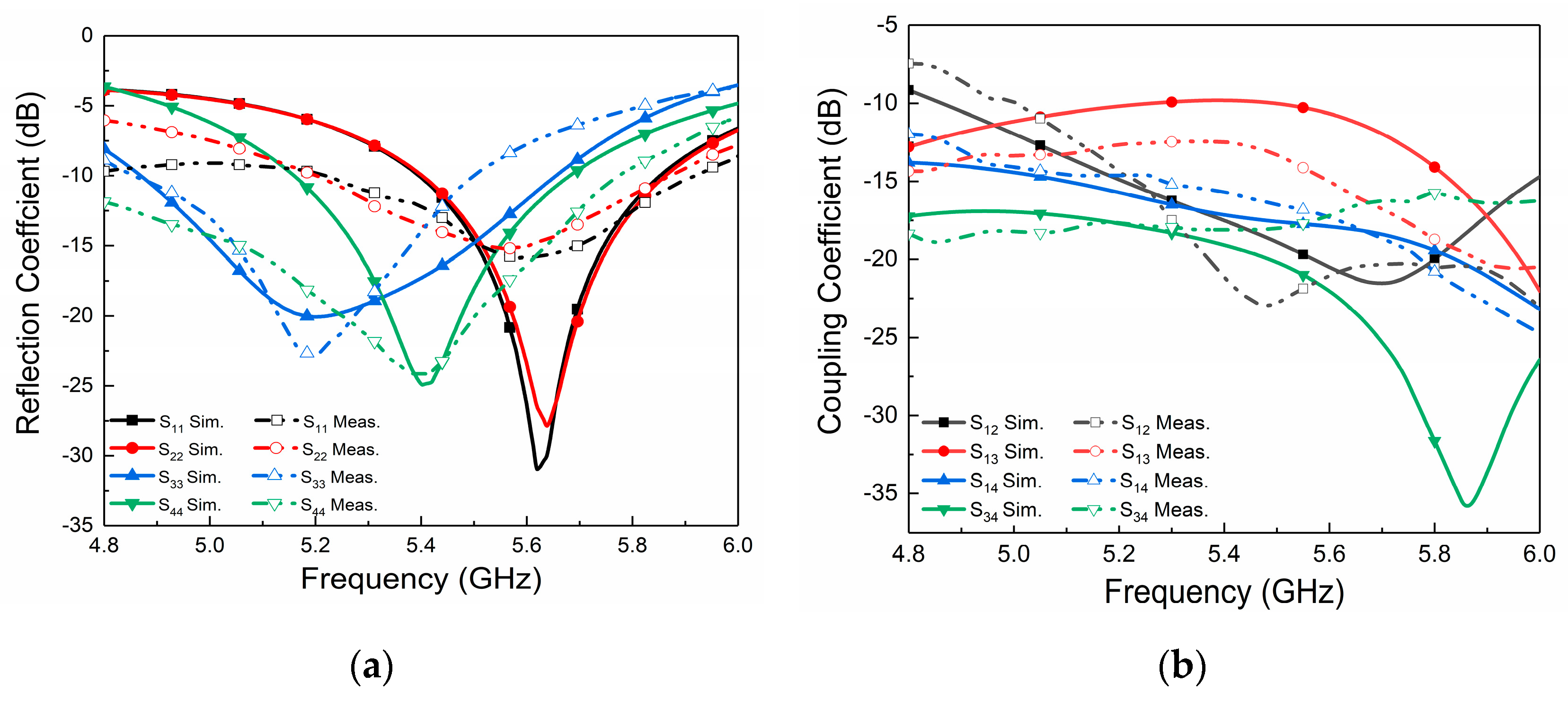

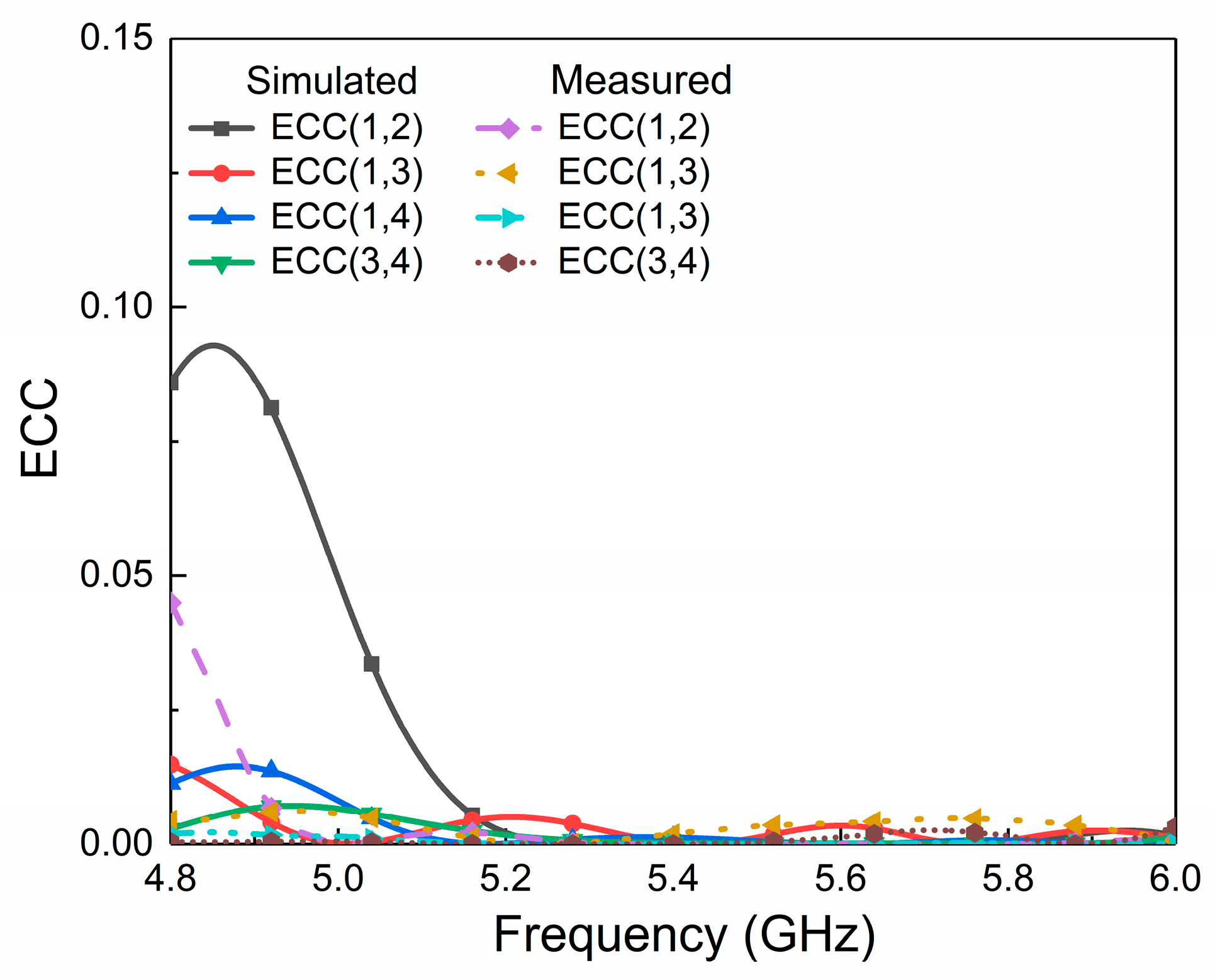
| Variable | Value | Variable | Value | Variable | Value |
|---|---|---|---|---|---|
| L | 30 | W1 | 2 | WS1 | 0.8 |
| D | 13 | H1 | 6.5 | LS1 | 13.5 |
| H | 6.5 | L1 | 8.5 | LS2 | 13.5 |
| P1 | 0.5 | PU | 1.1 | SL | 3.5 |
| LU | 22.5 | WU | 11 | SW | 1.6 |
| Ref. | No. of Ports | Decoupling Technique | Antenna Size | Operating Frequency Range (GHz)/Fractional Bandwidth | Max. Gain (dBi) | Isolation (dB) |
|---|---|---|---|---|---|---|
| [10] | 2 | Cylindrical air-gap | 0.735λ0 × 0.735λ0 × 0.159λ0 100 × 100 × 23.6 mm3 | 1.71–2.05, 2.5–2.7 (18%, 8%) | 5.5 | 17 |
| [13] | 3 | Polarization and pattern | 1.79λ0 × 1.79λ0 × 0.445λ0 56.6 × 56.6 × 14.09 mm3 | 9.12–9.84 (7.6%) | 8.1 | 20 |
| [15] | 2 | Metal strips | 1.818λ0 × 1.818λ0 × 0.254λ0 20 × 20 × 2.785 mm3 | 27.25–28.59 (4.8%) | 9.9 | 24 |
| [22] | 4 | FSS | 1.965λ0 × 1.965λ0 × 0.316λ0 112 × 112 × 16.6 mm3 | 5.15–5.35 (3.8%) | 7.2 | 22 |
| [25] | 2 | Higher-order modes | 0.86λ0 × 0.52λ0 × 0.49λ0 50 × 30 × 28.5 mm3 | 5.01–5.41 (7.7%) | 7.8 | 20 |
| [26] | 4 | Polarization and pattern | 0.75λ0 × 0.68λ0 × 0.21λ0 66 × 60 × 18.6 mm3 | 3.22–3.72 (14.4%) | 4.2 | 15 |
| This work | 4 or 2 | U-shaped slot | 0.54λ0 × 0.54λ0 × 0.145λ0 30 × 30 × 8.1 mm3 | 5.2–5.5, 5.2–5.9 (5.6%, 12.6%) | 7.1 | 12–23 |
Disclaimer/Publisher’s Note: The statements, opinions and data contained in all publications are solely those of the individual author(s) and contributor(s) and not of MDPI and/or the editor(s). MDPI and/or the editor(s) disclaim responsibility for any injury to people or property resulting from any ideas, methods, instructions or products referred to in the content. |
© 2023 by the authors. Licensee MDPI, Basel, Switzerland. This article is an open access article distributed under the terms and conditions of the Creative Commons Attribution (CC BY) license (https://creativecommons.org/licenses/by/4.0/).
Share and Cite
Li, X.-P.; Ji, J.-F.; Duan, C.-J.; Sun, Q.-Q.; Li, W.; Zhang, A.-X. A Four-Port MIMO Cylindrical DRA with High Isolation in Ultra-Compact Size for WLAN Applications. Micromachines 2023, 14, 1671. https://doi.org/10.3390/mi14091671
Li X-P, Ji J-F, Duan C-J, Sun Q-Q, Li W, Zhang A-X. A Four-Port MIMO Cylindrical DRA with High Isolation in Ultra-Compact Size for WLAN Applications. Micromachines. 2023; 14(9):1671. https://doi.org/10.3390/mi14091671
Chicago/Turabian StyleLi, Xue-Ping, Jun-Fei Ji, Chang-Jiao Duan, Qian-Qian Sun, Wei Li, and An-Xue Zhang. 2023. "A Four-Port MIMO Cylindrical DRA with High Isolation in Ultra-Compact Size for WLAN Applications" Micromachines 14, no. 9: 1671. https://doi.org/10.3390/mi14091671





